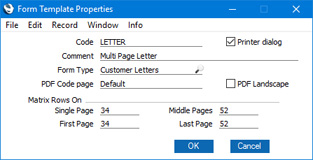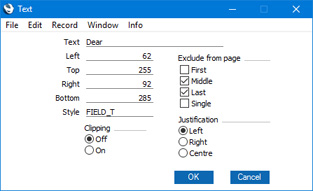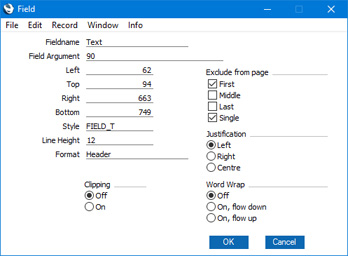Printing Customer Letters
You can print letters from a Customer Letter record using one of two methods. In both cases, if the Customer Letter record has not been marked as OK and if you are not using the No Test Printout option in the Optional Features setting in the System module, the phrase "Test Printout" will be printed diagonally across each letter as a watermark. The two methods are:
- With a Customer Letter record on screen, click the Printer icon (Windows/Mac OS X only). You can also select 'Print' from the File menu (all platforms).
- Use the 'Forms' function (accessible using the [Forms] in the Navigation Centre). Double-click (Windows/Mac OS X) or tap (iOS/Android) 'Customer Letters' in the resulting list. This method allows you to print letters from a range of Customer Letter records.
In both cases, the letters will be printed using a layout or template that you have designed using the Form Template register in the System module. You should design this layout or template to ensure the letters will be printed in your house style and that they fit on your headed stationery.
When you design the Form Template, you should take into account what is to happen when the printing of a letter requires more than one page. Usually, in such cases the address, date and header will be printed on the first page only. This means the letter text might start higher up on the second and subsequent pages compared to the first page.
To design the letter template follow these steps. You can only follow this process using Windows or Mac OS X, not iOS or Android.:
- Switch to the System module, click the [Registers] button in the Navigation Centre and double-click 'Form Templates' in the resulting list .
- The 'Form Templates: Browse' window will be opened, listing the existing Form Templates. To enter a new standard letter template, select 'New' from the Create menu; to modify an existing template, double-click it in the list.
- In the case of a new Form Template, select 'Properties' from the Operations menu.

Enter an appropriate Code and, using 'Paste Special' from the Form Type field, classify the Form Template as a Customer Letter. This will ensure that you will only be able to include fields appropriate to letters in the Template.
You should now calculate how many lines of letter text will be printed on each page of a multi-page letter. In the example we will use throughout this description, the first page has room for 34 lines of text, while the second and subsequent pages have room for 52. Enter these figures in to the four fields under the heading of Matrix Rows On, as shown in the illustration above.
These four fields represent different pages, as follows:
- First
- The first page of a multi-page document
- Middle
- In a multi-page document, the pages between the first and last pages.
- Last
- The last page of a multi-page document.
- Single
- The sole page of a single-page document.
Usually, the First and Single page designs will be the same (a single page letter will have the same appearance as the first page of a multi-page letter).
So, in this example, letters will be printed as follows, depending on the length of the letter text (i.e. on the number of lines): | Lines of Text | Pages | Type of Page | | Up to 34 | 1 | Single | | 35-87 | 2 | First and Last | | 88-139 | 3 | First, Middle and Last | | 140-191 | 4 | First, 2 x Middle, Last |
When all fields are complete, click the [OK] button in the dialogue box to close it.
- In this step, you will design the First and Single pages. Add fields and text elements as described below, so that the design ends up looking something like this:

To add a field to the design, click the [Field] button at the top of the window and then draw a box on the Form where the field is to appear. You can move or resize it later if necessary. The 'Field' window opens:

Enter the Field Name (use 'Paste Special' to see the available Field Names for the "Customer Letter" Form Type), and use 'Paste Special' again to choose a type style in the Style field.
Use the Exclude From Page options to set the page specification for each field. Tick the Middle and Last of these options, to signify that each field will be printed on the First and Single pages (i.e. they will be excluded from the Middle and Last pages).
In the case of the field representing the letter text itself, enter "Text" as the Field Name, and complete the other details as follows:
- Line Height
- Since the letter text is likely to extend over more than one line, you should specify a Line Height. If you leave it at 0 (the default), the lines of text will be superimposed on one another. In the case of 10 point Times, a Line Height of at least 10 points is recommended.
- Top, Bottom
- Don't forget to ensure that the Text field is deep enough to accommodate the required number of lines of text in the specified font (34 lines in the example).
- Field Argument
- Enter here the maximum number of characters that can be printed in one line. In the example illustration, it has been specified that up to 90 characters can be printed per line (fewer if the 90th character occurs in the middle of a word).
Click the [OK] button in the dialogue box to save the field specifications, and repeat as necessary until you have added every field to the First and Single pages.
You can add text elements to the design in a similar manner, by clicking the [Text] button at the top of the window and then drawing a box on the Form Template where the element is to appear. When the 'Text' window opens, type the text that is to be printed on the Form Template in the Text field. This can be up to 80 characters long, but it is limited to one line. To create a text area with more than one line, use the appropriate number of separate one-line text elements.
As with fields, assign the text elements to the First and Single pages using the Exclude From Page options, as shown:

Click the [OK] button in the dialogue box to save the text element specifications, and repeat as necessary until you have added every text element to the First and Single pages have been added.
- Now design the Middle and Last pages. In our example, they will be the same. To help with this, you can hide the elements added in step 4 above. To do this, select 'Middle Only' from the Operations menu. This displays only those elements that are to be printed on the Middle page. At this stage, there are no such elements, so the window goes blank. Add fields and text elements, so that the design looks something like this:

This time, use the Exclude From Page options to specify that each element will be printed on the Middle and Last pages (i.e. they will be excluded from the First and Single pages). In the case of the Text field, don't forget to ensure that it is deep enough to accommodate the required number of lines of text in the specified font (52 lines in the example):

- Now, choose 'View All' from the Operations menu. Every element from every page will be displayed. This allows you to confirm that the left-hand margins of each element are correctly aligned:

Note how the Text field from the Middle and Last pages starts higher up the page than the Text field from the First and Single pages.
- If any element is not aligned correctly, drag it into position using the mouse, or double-click it to open its specification window and type in the correct co-ordinates.
- When the design is complete, click the [Save] button in the Button Bar to save the Form Template.
- Now you should inform Standard ERP that the template you have just designed is to be used when printing letters. For details, please refer to the description of the 'Header' card of the Customer Letter record.
---
The Customer Letter register in Standard ERP:
Go back to:
|
